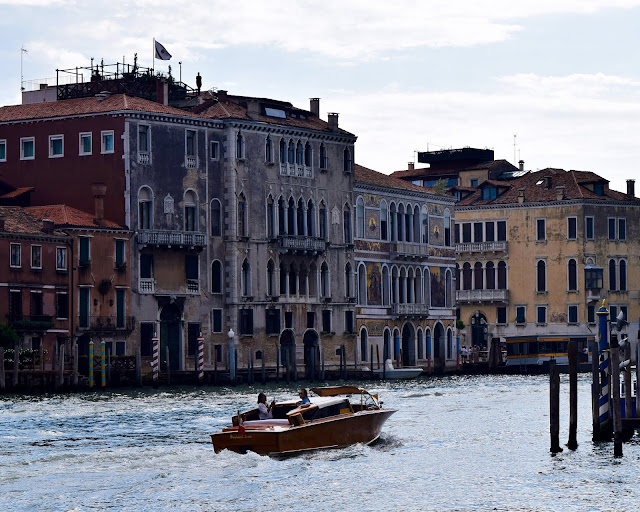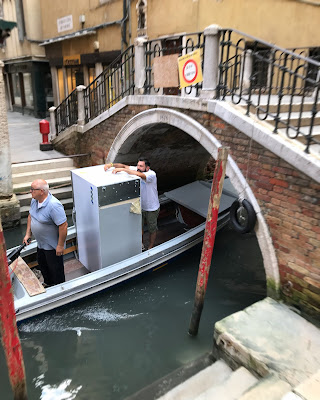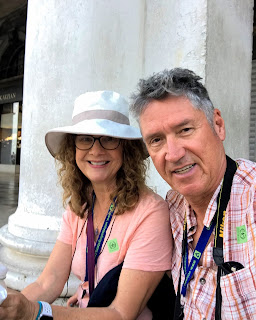Terry and I touched down at Marco Polo Airport late in the morning, the dome of the sky a marbled creation of resplendent sunlight and misty clouds. Once through customs, we followed the signs to the swift-moving walkways that would deliver us to the water transport terminal. The airport is on the mainland, but our destination was three miles off shore, glinting on the horizon: Venice. We were embarking on an eighteen-day tour of northern Italy that would begin and end in this city. In between, we would venture high into the Dolomites, and then descend upon sun-drenched Tuscany, the cradle of the Renaissance, where one can sit under a hillside olive tree all afternoon and watch clouds drift across the sky and not feel that the day was wasted. Our plan was to take it slow and easy; bask in the vibe that is Italy. La vita bella!
Aboard the water bus, we plied across the Venetian Lagoon and watched the city grow on the horizon. Bell towers, cathedral domes, columned facades, all built of weathered stone and brick, gradually consumed the cabin windows. There was not a speck of bare ground to be seen anywhere, not even a small hill. The city literally appeared to rise from the water and float upon its surface.
San Marco was our stop. We wheeled our luggage off the water bus into a swarm of people, enraptured by the sights and sounds of another world. Through a labyrinth of colossal buildings and crowded plazas we wandered, searching for our hotel with map in hand. It was supposed to be a “600-meter walk” from the bus stop, only we strayed off course more than once. Sometimes an avenue’s name is painted on the corner of a building. But most times, it’s not. Welcome to Venice. The adventure begins.
~~~~~~~
Venezia
The Hotel Al Gazzettino where we were staying is right in the middle of the San Marco borough: a five-minute walk to the Rialto Bridge in one direction, and a five-minute walk to Saint Mark’s Square in the other direction. We had three days to explore the city—and in retrospect, that wasn’t enough time. But we made the best of it.
The founding of Venice goes back fifteen centuries to the collapse of the Roman Empire, when the region suffered from Germanic and Hun invasions. Its name is derived from the Veneti people who settled in the marshy lagoon islands to better defend themselves against marauders. Unlike most feudal realms of the Middle Ages, the Venetians gained their wealth and power not by owning large parcels of land that were worked by throngs of serfs, but rather by securing lucrative trade routes: silk from China; spices from the Indies; gems from Egypt. They would become the virtuoso merchants, presiding over most of the commerce to and from distant lands and making Venice the first international market hub in Europe.
Ocean routes established by Portugal and Spain to the Far East in the 16th century severed Venice’s trade monopolies to those lands. But always the savvy merchant, the Venetians leveraged their wealth to expand commerce in other directions. This acquired wealth shows in the old palatial homes, government buildings, music halls, and cathedrals of yesteryear. It was a city-state republic for nearly a millennium—from the 8th century, to its surrender to Napoleon Bonaparte in 1797. The Renaissance artwork of Bellini and Titian (both natives of Venice) adorn the Doge’s Palace and several churches, and the pitch-perfect notes of opera and the music of Vivaldi still waft across the Piazza. Walking the streets here is indeed like walking through time.
 |
| Church of San Giorgio Maggiore. Completed in 1610. Designed by Andrea Palladio, one of the most influential architects from the Renaissance era. |
 |
| Another view into Piazza San Marco. |
 |
| Hiding from the Paparazzi. |
 |
| Sangiovese and summer showers. |
 |
| A quiet neighborhood. |
 |
| Early evening on the Grand Canal. |
 |
| Lost in the Castello borough. |
Water World
How did this detail get by me?
Venice is built on a cluster of 118 small islands that are not much higher than high tide, linked together by a network of 150 canals and over 400 footbridges. To keep the buildings from settling into the marshy ground, even the giant Saint Mark’s Basilica, millions of wood pilings were driven vertically into the mud (by hand!) to form a solid foundation—an engineering marvel when you consider how long ago it was done.
Hence there are only two modes of travel in this city: by foot, or by boat. Water buses run on regular schedules around the islands and along the Grand Canal. There are also water taxis for hire (but they’re not cheap). Many residents own a motorboat of some sort, which they tie up in front of their home, or keep in a boathouse underneath the home. And then, of course, there’s the iconic gondolas, which are mostly used now to pole tourists around. Need an ambulance? It’s a speedboat with a siren and flashing lights. Police? Same thing. Garbage is collected and taken away by boat. Your Amazon Prime delivery comes to you via boat, as does all the merchandise that you buy in town. The canals have a speed limit and the cops use radar guns to enforce it. And what’s in the fire station? You guessed it.
 |
| Morning "work traffic" on a side canal. Vessel at right foreground is city police. |
 |
| Private powerboat on the Grand Canal. |
 |
| A 1732 painting by Venetian artist, Canaletti, portrays the Ascension Day Regatta on the Grand Canal, a festive event that is still held today. |
 |
| Delivering a refrigerator. |
Empire
According to Forrest Gump, “Life is like a box of chocolates: you never know what you’re gonna get." In that respect, wandering the cobbled lanes of Venice was sometimes like a box of chocolates—you never knew where you might end up next. We roamed the San Marco and Castello boroughs one day, from the crush of the Piazza San Marco to the tranquil, off-the-beaten-path nooks in Castello—which is how we stumbled upon the San Lorenzo Church where Marco Polo is buried. Then again, not everything we did was random. Here are three of them…
MUSEO STORICO NAVALE
In the year 1204, Venice allied with the Franks for the Fourth Crusade with the intent of taking back Jerusalem from the Muslims—only they didn’t quite reach the Holy Land, and sacked the Byzantine Christian capital of Constantinople instead. The Venetians, who had the most formidable navy in the Mediterranean throughout the 13th and 14th centuries, built the entire war fleet for this endeavor in the fortified Arsenal shipyard behind the Naval Historical Museum. The Arsenal was the largest factory complex in Europe before the Industrial Revolution, employing 16,000 Venetians at its peak. Today the 110-acre site is an Italian navy station, closed to the public except for the buildings that house the museum. Plenty of maritime exhibits to be seen here, from scale models of medieval war galleys to full-size restorations of various boats.
 |
| Entrance to the Arsenal. |
 |
| Bragozzo fishing boat: a Venetian shallow-draft design that goes back 600 years. |
 |
| The winged lion of Saint Mark at the bow of the Royal Barge used by King Emmanuel II in 1866 when Venice joined the Kingdom of Italy. |
 |
| Guilded engravings on the Royal Barge. |
SAN MARCO BASILICA
In the 9th century, two Venetian merchants in Egypt absconded with the mummified remains of Mark the Evangelist and spirited him away to Venice, where he was to be entombed under a grand cathedral that had yet to be built. Saint Mark’s Basilica was completed in 1094, though additions and enhancements would continue for centuries. The opulent Byzantine domes and spires are a sight to behold. Inside, the entire ceiling of the vaulted nave is adorned with detailed mosaics on a background of gold tiles. One can also venture down to the crypts and behold Saint Mark’s tomb. It rests directly below the main church alter on the floor above. Impressive.
 |
| More war plunder: Ancient Greek and Byzantine columns (over 500!) that were looted from Constantinople embellish the front of the Basilica. |
 |
| If it looks like gold, it is. |
PALAZZO DUCALE
Sited adjacent to Saint Mark’s Basilica, the Doge’s Palace was the power center of the Venetian Republic. It was not only the Doge’s residence, but also housed the Great Council’s governing chambers and halls. There are sculptures and artwork throughout, created by Venice’s greatest masters: Carpaccio; Vivarini; Giorgione; Bellini; Titian… Our three hours spent with an awesome guide, who showed us both the Palazzo Ducale and San Marco Basilica, was worth every minute.
 |
| Stairway to the Doge's residence. |
 |
| Taking a break. (Hey, being a tourist is hard work!) |
 |
| The cavernous Hall of the Great Council, where the power brokers of the empire gathered. And yep, that’s all gold on the ceiling. |
 |
| The weapons room in the garrison. |
Island of Glass
My wife loves all things glass of the artistic flair. When we were in Ireland three years ago, the Waterford factory was on her hit list of things to see. Happy wife, happy life. Though to be honest, watching a glass-blower create art out of sand was pretty cool—or should I say pretty hot, because a lot of flame and heat goes into the process. And now that we were in Venice, guess what? It’s renowned for making fancy glass things.
One morning we hopped on the water bus that goes out to Murano Island, a small isle about a half mile northeast of Venice. That’s where all the glassmakers are now, ever since the year 1291 when they were banished from Venice for starting too many blazes (it’s that flame and heat thing). Many of the five thousand residents on Murano have some connection to the glass trade. Tidy homes and shops line the streets and canals. I followed Terry through a couple of workshops where glass-blowers were demonstrating their talents. We also browsed through the Museo del Vetro (Museum of Glass) and I don’t know how many glass stores. Ter was in her element. Like I was saying: happy wife, happy life.
 |
| The serene, downtown Murano. |
 |
| Lost in a glass shop. |
 |
| I'm thinking this would look fabulous in our entryway. |
A Night at the Opera
My first exposure to opera came at the age of nine. I was watching The Little Rascals on TV where Alfalfa warbled out a madcap rendition of “The Barber of Seville.” And then, of course, there was the rollicking Lone Ranger theme song, another show that I watched every day after school with cookies and milk. Little did I know at the time, but both songs came from operas, and both were composed by Gioachino Rossini almost two hundred years ago. Or take the latest Volvo commercial that lifts an aria from Mozart’s "The Magic Flute." It tells you something about the permanence of the genre. Old, maybe. But everlasting.
Opera may have got its start in Renaissance-era Florence, but Venice is where it evolved into a phenomenon, with six large opera houses in operation by the late 18th century. They were the rock concerts of the day, steeped in pageantry and theater. Neither of us had ever been to one before. So, it only made sense that if in Venice…
I found a concert featuring arias from renowned operas by Puccini, Mozart, Rossini, Verdi… That would get our feet wet. The performance was at the Scuola Grande di San Teodoro, a grandly-refurbished music hall that was built in 1580 to serve as a music academy. The singers were extraordinary, backed by a very adroit twelve-piece orchestra. The soprano’s voice especially resonated through the hall like a miracle. Mesmerizing. In all, it was an engaging night at the opera. In Venezia!
 |
| The best restaurants are tucked away on the side canals. |
 |
| The opening aria from Rosinni's "The Barber of Seville." |
 |
| A duet from Mozart's "Don Giovanni." |
 |
| The ever-popular "Drinking Song" from Verdi's "La Traviata". This was the finale and brought down the house to a standing ovation. |
 |
| Late-night gondola ride. Best time to go. |
 |
| Walking back to the hotel. |
~~~~~~~
On the morning of Day 4, we checked out of the Hotel Al Gazzettino and hoofed it to the Rialto ferry terminal to catch the water bus out of the city. The sidewalks and plazas were still quiet. Shopkeepers were busy opening their stores, preparing for the crush of tourists that would soon come. As for us, we were returning to the mainland to pick up our rental car and start the next leg of the adventure: The Dolomites…
Navigation to...
PART TWO PART THREE PART FOUR













Sure is a lot more history over there...thanks.
ReplyDeleteBeautiful! I wish I had gone to the opera when I was in Venice... big sigh... another trip, perhaps?!
ReplyDeleteBritney, you'll just have to go back. :-)
DeleteNo argument from me. Marvelous post, Ron! You could make a living doing this but that might take the fun out of it.
Delete